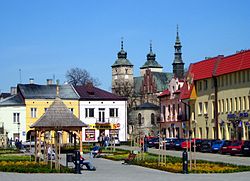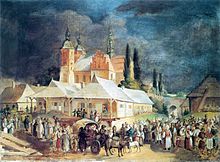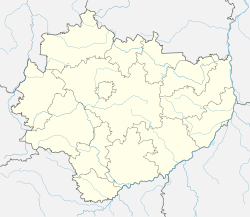Opatów
Opatów | |
|---|---|
 Main Square in Opatów | |
| Coordinates: 50°48′18″N 21°25′29″E / 50.80500°N 21.42472°E | |
| Country | |
| Voivodeship | Świętokrzyskie |
| County | Opatów County |
| Gmina | Gmina Opatów |
| Founded | 10th–11th century |
| First mentioned | 1189 |
| Town rights | 1282 |
| Area | |
• Total | 9.36 km2 (3.61 sq mi) |
| Population (2012) | |
• Total | 6,658 |
| • Density | 710/km2 (1,800/sq mi) |
| Postal code | 27-500 |
| Area code | +48 15 |
| Car plates | TOP |
| Website | http://www.umopatow.pl/ |
Opatów ([ɔˈpatuf] ; Template:Lang-yi) is a town in Poland, in Świętokrzyskie Voivodeship, historic province of Lesser Poland. It is the capital of Opatów County. Its population is 7,833 (2007). Opatów is located among the hills of Lesser Polish Upland, with the Opatówka river dividing the town into two parts. The town marks the intersection of two main roads - European route E371, and national road nr 74 (Piotrków Trybunalski – Hrubieszów). Opatów, however, has no rail connection. Nearest station is at Ostrowiec Świętokrzyski, 17 km (11 mi) away.
Tourist attractions include a 12th-century Collegiate Church of St. Martin, 15th-century baroque Bernardine monastery, 16th-century city gate, and several other notable buildings.
History

In the Middle Ages, Opatów was a settlement on the Opatówka River, in an area of forests and lakes. It was founded as a stronghold of the early Polish state in the late 10th or early 11th century. First mentioned in 1189, it was the residence of the regional ruler (Castellan) and one of the largest settlements of the Sandomierz Land. First church was built here sometime in the 11th century. In the 12th century, St. Martin collegiate church was built as well. The purpose of the collegiate church is not known, it was probably designed for a Roman Catholic diocese which was created in Sandomierz instead.
In 1232, Polish Duke Henry the Bearded transferred Opatów to Lawrence, Bishop of Lubusz. In 1237, it was granted privileges that regularized the status of its residents and in 1282 it received the status of a city with wide privileges. In the first half of the 14th century, Bishop of Lubusz Stefan II decided to move the center of the town to the hill near the collegiate church. New town was called Great Opatów (Opatów Wielki), also Magnum Oppathow and Magna Opatow.

For centuries, until the Partitions of Poland, Opatów was an important regional center of Lesser Poland. During an invasion of the Tartars (1502), the town was destroyed. In 1514, it was transferred to Krzysztof Szydłowiecki, who restored it, surrounded with a defensive wall, built a castle and offices for the local government, and improved the water supply to the residents. Opatów had two annual fairs and two market days a week. It was a private town, administratively located in the Sandomierz County in the Sandomierz Voivodeship in the Lesser Poland Province of the Polish Crown.[1] In the 16th century, Opatów had a population of roughly 4,000 and was the biggest town of the province, even bigger than Sandomierz. The town was a center of political life of the Voivodeship; here General Sejmiks of the Lesser Poland Szlachta nobility took place. In 1551 Opatów burned almost completely. The great fire marked a slow decline of the town. In 1655, Opatów was destroyed in the Swedish invasion of Poland. The town also suffered during other conflicts including the Great Northern War, the Bar Confederation, the Polish–Russian War of 1792, and the Kościuszko Uprising. It belonged to a number of noble families (Tarnowski family, Ostrogski family, Lubomirski family, Potocki family, and Karski family), and remained in private hands until 1864.

In the 18th century, Opatów became home to a number of Greeks, who had escaped to Poland from the Turkish occupation of their homeland (see Ottoman Greece). They were allowed to open Orthodox churches. In 1778, an Orthodox parish of St Nicholas was opened, which in 1837 was moved to Radom.
The town was annexed by Austria in the Third Partition of Poland in 1795, in 1809 regained by Poles and included within the short-lived Duchy of Warsaw, in 1815 it fell to the Russian Partition of Poland. During the January Uprising, two battles took place in Opatów between Russians and II Corps of General Józef Hauke-Bosak. Poles captured the town on November 25, 1863, and withdrew with seized Russian guns and ammunition. On February 21, 1864, the second battle took place. It was one of the largest skirmishes of the uprising, and it ended in Polish defeat. Polish commander Ludwik Zwierzdowski was executed by the Russians at the market square on February 23, 1864.[2] Poland eventually regained independence in 1918, after World War I. In 1924 a monument to Ludwik Zwierzdowski was erected at the market square.[3]
During the joint German–Soviet invasion of Poland, which started World War II, in September 1939, Opatów was invaded and afterwards occupied by Germany. In 1939, the Germans ordered the demolition of the Ludwik Zwierzdowski monument, so the local mayor buried it to preserve it, thanks to which it was restored after the war.[3] In 1940 the Germans carried out mass arrests of Poles as part of the AB-Aktion. Poles arrested in March were either deported to Nazi concentration camps or massacred in Góry Wysokie, while those arrested in June were imprisoned and tortured in Skarżysko-Kamienna and then murdered.[4] Opatów was a large center of the Polish underground resistance movement. Underground Polish press printed in nearby Sandomierz was distributed in Opatów since 1940, and from November 1943 a secret Polish printing house was also launched in Opatów.[5] On March 11, 1943, the Germans carried out mass arrests of local Poles, including resistance members.[6] On the night of March 12–13, 1943, a Polish underground partisan unit Jędrusie, together with soldiers of the Home Army, carried out an successful attack on the local German prison and liberated 80 prisoners, before the Germans would deport them elsewhere.[6] In June 1944, the Home Army assassinated the local Gestapo chief Otto Schultz.[7]
Jewish community of Opatów

Opatów was the first town in the Sandomierz Voivodeship, in which Jews settled.[8] The original Jewish privileges were issued in 1545 by the Grand Crown Hetman Jan Tarnowski, the starost of Sandomierz and the owner of Opatów.[8] Local Jewish community was first mentioned in the books of the Roman Catholic ecclesiastical Chapter in 1612.[8]
Prior to World War II, Opatów had a substantial Jewish population. Known as 'Apt' in Yiddish, Opatów became home to 6,000 Jews with a history of rich cultural and religious life. Best known from among the locals was the 18th century Rabbi Avraham Yehoshua Heshel (Apter Rebbe), who was instrumental in the development of the Chasidic movement, and the famous Noda Be'Yehuda of Prague, one of the leading halakhic authorities of 18th Century Europe. Jewish life in Apt has been chronicled by Professor Gershon Hundert in his 1992 book The Jews in a Private Polish Town, drawing upon a variety of sources from the history of Jews in Poland.[9] The work describes the demographic and historical background as well as the structure of the Jewish community of Apt (Opatów) with a population numbering about 2,000 in 1765, exceptionally large for any Jewish shtetl in the 18th century Europe. The town's Jewish inhabitants enjoyed considerable prominence also in the following centuries. Hundert uses the Jewish Opatów as a case study for Polish Jewry. More than three-quarters of them lived on private lands of powerful magnate aristocrats known as the Szlachta. Hundert's work also describes the vibrant interaction of the Jews of Apt with their Polish Christian neighbours. It is a challenge to previous historiography which describes Jewish life in Poland in alleged isolation.[9]

During World War II the community was herded into the new Opatów Ghetto set up by Nazi Germany along the Joselewicza, Zatylna, Wąska and Starowałowa Streets. The ghetto held about ten thousand Jews. It was destroyed during the Holocaust in Poland,[10] with about 8,000 Ghetto inmates deported to Treblinka extermination camp throughout October 1942 and additional 2,000 Jews sent to labour camps never to return.[11] Only about 300 of Opatów's pre-war Jewish population of around 5000 survived.[12]
Economy
After the war, the city developed textiles and food manufacturing industries. The new housing estate and a Cultural Centre were built. Currently, the city sees its opportunities in the further development of tourism. However, there is no train station in Opatów – the nearest station is in Ostrowiec, 17 kilometres (11 mi) distance. Communication network consists of a city bus and private bus companies. The key focus areas of municipal government are the development of technical infrastructure, tourism, small business, attracting investors, and the promotion of education as well as the city itself. Traditional occupations and sources of income include agricultural farms, crafts, services and trade.[13]

Twin towns
Opatów is twinned with:
 Modrý Kameň, Slovakia
Modrý Kameň, Slovakia
People
- Witold Gombrowicz, born in nearby village of Maloszyce.
- Włodzimierz Mazur, football player
- Tomasz Żelazowski, football player
- Avraham Yehoshua Heshel of Apt (Apter Rebbe, Apter Rov), lived here
- Itche Goldberg, Yiddish writer and scholar of Yiddish culture.
- Yisroel Hopsztajn (Hapstein)
- Mayer Kirshenblatt
- Yechezkel Landau, rabbi of Prague
- Peter Litvin, musician, a descendant of Ruhlzalski Family of Opatow
Notes
- ^ Województwo sandomierskie w drugiej połowie XVI wieku; Cz.1, Mapy, plany (in Polish). Warszawa: Wydawnictwo Naukowe PWN. 1993. p. 4.
- ^ "156 lat temu, podczas Powstania Styczniowego rozegrała się bitwa opatowska. Zobaczcie jak przebiegała (ZDJĘCIA)". echodnia.eu (in Polish). Retrieved 21 November 2020.
- ^ a b "Pomnik majora Ludwika Zwierzdowskiego". PolskaNiezwykla.pl (in Polish). Retrieved 21 November 2020.
- ^ Wardzyńska, Maria (2009). Był rok 1939. Operacja niemieckiej policji bezpieczeństwa w Polsce. Intelligenzaktion (in Polish). Warszawa: IPN. pp. 251–252, 268.
- ^ Gruszczyński, Włodzimierz (2011). Odwet i Jędrusie (in Polish). Zagnańsk. pp. 32, 153.
{{cite book}}: CS1 maint: location missing publisher (link) - ^ a b "12 marca 1943 r. Oddział partyzancki „Jędrusie" rozbił więzienie w Opatowie i uwolnił 80 więźniów". Interia Nowa Historia (in Polish). Retrieved 21 November 2020.
- ^ "Obelisk upamiętniający akcję AK". PolskaNiezwykla.pl (in Polish). Retrieved 21 November 2020.
- ^ a b c Virtual Shtetl (2014). "History of the Jewish community in Opatów". Museum of the History of Polish Jews. Part one of five. Archived from the original on 24 September 2015. Retrieved 16 July 2014.
- ^ a b Hundert, Gershon David (1992). The Jews in a Private Polish Town: The Case of Opatow in the Eighteenth Century (Google Books). Baltimore and London: The Johns Hopkins University Press. Retrieved 18 July 2014.
- ^ Virtual Shtetl (2014). "World War II ghetto in Opatów". Museum of the History of Polish Jews. Archived from the original on 3 July 2017. Retrieved 16 July 2014.
- ^ Overview: "Getta Żydowskie" by Gedeon (in Polish) and "Ghetto List" by Michael Peters (in English).
- ^ Megargee, Geoffrey (2012). Encyclopedia of Camps and Ghettos. Bloomington, Indiana: University of Indiana Press. ISBN 978-0-253-35599-7.
- ^ City Hall (2013). "Opatów. Okres powojenny (Postwar period)". Urząd Miasta i Gminy w Opatowie. Archived from the original on 7 December 2013. Retrieved 19 July 2014.
External links
- Official town website
- Saint Martin's Church in Opatów
- Jewish Quarterly Review, The Jews in a Polish Private Town by Gershon David Hundert. Center for Advanced Judaic Studies, University of Pennsylvania 1996.
- Gershon David Hundert, The Jews in a Polish Private Town: The Case of Opatów in the Eighteenth Century. Hardcover. The Johns Hopkins University Press, December 1, 1991 (Amazon); including Editorial Reviews. ISBN 0801842735.
- Opatów, Poland at JewishGen





